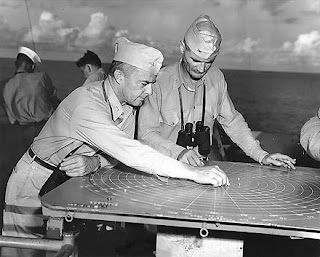 |
| Fleet Admiral Ernest J. King, USN |
Japanese raids were frequent and heavy even though carried out at severe cost to the enemy. During this period of stepped up air operations, our advance base in the Russell Islands was in constant use by our planes.” By April Guadalcanal, although still constantly under air attack, was considered little more than a rear guard base where tired destroyer officers and PT skippers could drink their beer in relative comfort at the Club de Slot, a thatched roof hut overlooking Savo Sound. Guadalcanal, too, was the haven of harried Comairsols––wizened, taciturn Rear Admiral Marc A. “Pete” Mitscher, one of the most favorable flag officers of the later war––who commanded all Navy, Army, Marine Corps and New Zealand aircraft and pilots in the area.
 |
| Vice Admiral Marc A. Mitscher |
Notwithstanding Mitscher’s endeavors to build up his air defenses, attacks on Guadalcanal continued through May and June. On the 16th the island was subjected to one of the most devastating air strikes of the campaign. A force of enemy aircraft estimated at one hundred and sixty fighters and bombers was engaged by more than one hundred American fighters form the Army, Navy and Marine Corps. One hundred and seven enemy aircraft were destroyed at a cost of six fighter planes, one lighter and one cargo ship.
 |
| Aaron S. Merrill and Captain W.D. Brown during operations in the Solomon Islands, 23 December 1943 |
The landings at Rendova and the struggle to capture the Japanese air base of Munda on New Georgia are reported by war correspondent-novelist William Bradford Huie.
From: The United States Navy in World War II
Compiled and edited by: S. E. Smith
Compiled and edited by: S. E. Smith

No comments:
Post a Comment